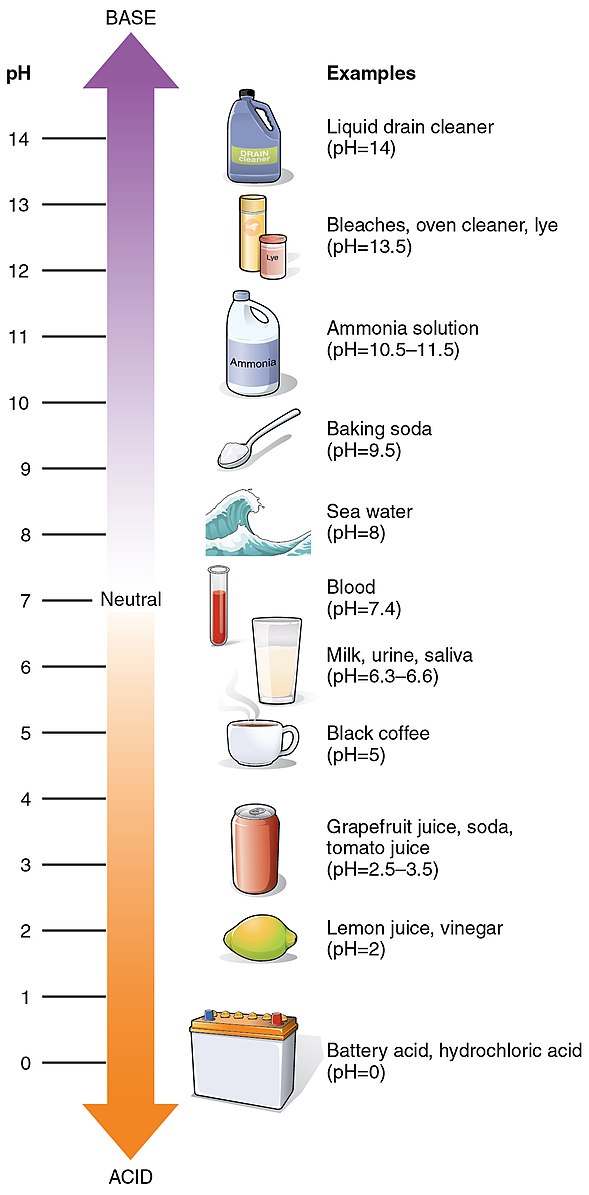The pH of DNA in water is a crucial factor that affects its stability and integrity. DNA is most stable in a neutral pH range, specifically between pH 5 to 9. At pH levels below 5, DNA is susceptible to depurination, leading to the breakage of phosphodiester bonds and base pairs. Conversely, at pH levels above 9, DNA is prone to alkaline denaturation due to the abundance of hydroxide ions, which remove hydrogen ions from the base pairs, causing them to denature.
Maintaining the Neutral pH Range
To ensure the stability and integrity of DNA in water, it is essential to maintain the pH within the neutral range. This can be achieved by using appropriate buffers, such as Tris-EDTA buffer, which has a pH of 9 and is commonly used to preserve DNA. However, it is crucial to note that leaving DNA in water, regardless of the pH, can lead to its degradation due to acid hydrolysis, particularly below pH 7.5.
Contaminants and Substances Affecting pH
 Image source: OpenStax College
Image source: OpenStax College
Contaminants, chemicals, and substances that can affect the pH of DNA in water include metal ions, such as divalent and monovalent ions. Divalent metal ions, like magnesium and calcium, can promote DNA sedimentation, while monovalent ions, such as sodium and potassium, do not have this effect.
Dealing with Contaminants and Substances
To deal with contaminants and substances that can affect the pH of DNA in water, it is recommended to use chelating agents, such as ethylenediaminetetraacetic acid (EDTA), which can bind to metal ions and prevent them from interacting with DNA. Additionally, it is crucial to handle and store DNA in appropriate containers, such as microcentrifuge tubes, to prevent contamination and ensure its stability and integrity.
Factors Affecting DNA Stability in Water
The stability of DNA in water can be influenced by various factors, including:
- pH: As mentioned earlier, maintaining the pH within the neutral range is crucial for DNA stability.
- Metal Ions: Divalent metal ions, such as magnesium and calcium, can promote DNA sedimentation and affect its stability.
- Contaminants: Other contaminants and substances, such as chemicals and organic matter, can also impact the pH and stability of DNA in water.
Preserving DNA Integrity in Water
To preserve the integrity of DNA in water, it is essential to follow these best practices:
- Use Appropriate Buffers: Employ buffers like Tris-EDTA to maintain the pH within the neutral range.
- Avoid Prolonged Exposure: Minimize the time DNA is left in water, as prolonged exposure can lead to degradation.
- Minimize Contamination: Handle and store DNA in clean, appropriate containers to prevent contamination.
- Utilize Chelating Agents: Use chelating agents, such as EDTA, to bind and remove metal ions that can affect the pH and stability of DNA.
Conclusion
In conclusion, maintaining the pH of DNA in water within the neutral range is crucial for ensuring its stability and integrity. By using appropriate buffers, handling DNA in clean containers, and addressing contaminants and substances that can affect the pH, DIY users with advanced hands-on skills can effectively preserve the integrity of DNA in water.
References:
– Acidity promotes degradation of multi-species environmental DNA in aquatic environments. Nature Communications, 2015, 6(1), 1-8.
– How does pH affect DNA stability? AAT Bioquest.
– Insights on the DNA Stability in Aqueous Solutions of Ionic Liquids. Frontiers in Bioengineering and Biotechnology, 2020, 8, 547857.
– Effects of water pH and proteinase K treatment on the yield of environmental DNA from water samples. Limnology, 2017, 18(1), 1-7.
– Evaluation of DNA extraction yield from a chlorinated drinking water distribution system. Science of the Total Environment, 2021, 759, 143654.
– pH-dependent sedimentation of DNA in the presence of divalent, but not monovalent, metal ions. Biochemistry, 2020, 59(52), 6368-6374.
